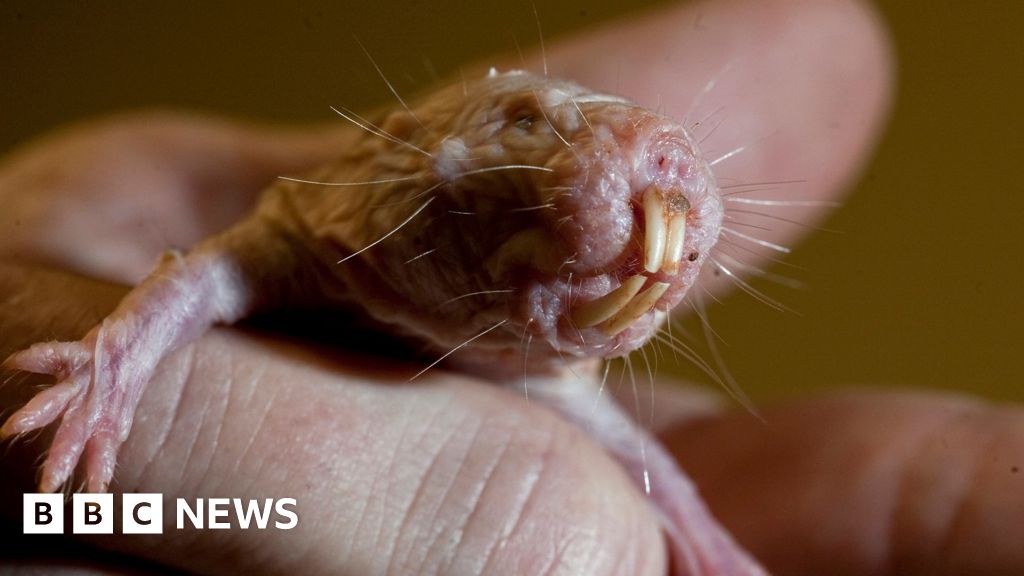Mole rats—living the good life
Editor’s summary
Somewhat lacking in good looks, the naked mole rat gets attention because it is very long lived and highly resistant to cancer. Chen et al. revealed a molecular mechanism that contributes to successful aging in these rodents: a change in the enzyme cyclic guanosine monophosphate-adenosine monophosphate synthase (cGAS), which is known to sense cytosolic DNA and initiate immune defense responses (see the Perspective by Martinez et al.). Unlike human cGAS, which inhibits DNA repair by homologous recombination in the nucleus, the naked mole rat enzyme has four amino acid changes that allow it to enhance DNA repair, thus delaying aging and enhancing life span. —L. Bryan RayStructured Abstract
INTRODUCTION
The naked mole-rat (Heterocephalus glaber) is an extraordinarily long-lived rodent with a maximum life span of ∼37 years. Although its exceptional longevity is thought to result from a combination of adaptations affecting diverse biological processes, the molecular mechanisms protecting the naked mole-rat from genomic instability—a primary hallmark of aging—remain unclear.RATIONALE
DNA repair constitutes a crucial mechanism for stabilizing the genome. Earlier studies have demonstrated that the DNA sensor cyclic guanosine monophosphate–adenosine monophosphate synthase (cGAS) participates in regulating DNA double-strand break repair by suppressing the homologous recombination (HR) pathway, thereby promoting genomic instability. Although enhanced function of DNA repair proteins contributes to the evolution of longevity, it remains unexplored whether evolution has selected for the attenuation of negative regulators such as cGAS.RESULTS
In a panel of assays, we found that naked mole-rat cGAS, in contrast to human and mouse cGAS, enhanced HR repair efficiency. This functional reversal is mediated by the substitution of four specific amino acid residues within the C-terminal domain of the cGAS protein. Mechanistically, this amino acid alteration enabled naked mole-rat cGAS to prolong its retention on chromatin in the wake of DNA damage by modulating its ubiquitination status, thereby altering its interaction with the segregase P97. The prolonged presence of naked mole-rat cGAS on chromatin facilitated the formation of a complex between the canonical HR factor RAD50 and FANCI, a factor primarily associated with the Fanconi anemia pathway. We further demonstrated that FANCI promoted the chromatin recruitment of RAD50, thereby potentiating HR repair. Consequently, naked mole-rat cGAS attenuated stress-induced cellular senescence, mitigated organ degeneration, and extended life span in fruit flies. Critically, reverting these four amino acid residues abolished these protective effects. Furthermore, adeno-associated virus–mediated delivery of naked mole-rat cGAS to aged mice reduced frailty, attenuated hair graying, lowered circulating levels of immunoglobulin G and interleukin-6, and decreased cellular senescence markers in multiple tissues. Once again, these beneficial effects were dependent on the four specific amino acids.CONCLUSION
Using comparative molecular biology, our work reveals that the negative regulatory function of cGAS in HR repair is reversed in the longest-lived rodent, the naked mole-rat, by an alteration of four specific amino acid residues. This alteration confers naked mole-rat cGAS with a greater capacity to stabilize the genome, counteract cellular senescence and organ aging, and promote extended life span and health span.
Divergent cGAS function in naked mole-rats.
The cGAS-mediated suppression of homologous recombination repair is reversed in the longest-lived rodent, the naked mole-rat. Four amino acid changes maintain its cGAS at a low level of ubiquitination after DNA damage, conferring prolonged chromatin binding (E, Glu; S, Ser; T, Thr; Y, Tyr). This facilitates FANCI and RAD50 interaction, enhancing HR repair. These molecular changes contribute to reduced cellular senescence, delayed organ aging, and life-span extension. [Figure created with BioRender.com]

